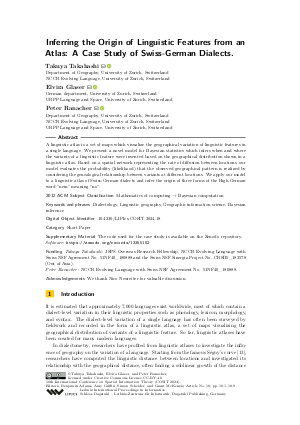Inferring the Origin of Linguistic Features from an Atlas: A Case Study of Swiss-German Dialects. (Short Paper)
Authors
Takuya Takahashi  ,
Elvira Glaser
,
Elvira Glaser  ,
Peter Ranacher
,
Peter Ranacher 
-
Part of:
Volume:
16th International Conference on Spatial Information Theory (COSIT 2024)
Part of: Series: Leibniz International Proceedings in Informatics (LIPIcs)
Part of: Conference: Conference on Spatial Information Theory (COSIT) - License:
 Creative Commons Attribution 4.0 International license
Creative Commons Attribution 4.0 International license
- Publication Date: 2024-09-09
File

PDF
LIPIcs.COSIT.2024.18.pdf
- Filesize: 2.35 MB
- 9 pages
Document Identifiers
Subject Classification
ACM Subject Classification
- Mathematics of computing → Bayesian computation
Keywords
- Dialectology
- Linguistic geography
- Geographic information science
- Bayesian inference
Metrics
- Access Statistics
-
Total Accesses (updated on a weekly basis)
0PDF Downloads0Metadata Views
Abstract
A linguistic atlas is a set of maps which visualize the geographical variation of linguistic features in a single language. We present a novel model for Bayesian statistics which infers when and where the variants of a linguistic feature were invented based on the geographical distribution shown in a linguistic atlas. Based on a spatial network representing the rate of diffusion between locations, our model evaluates the probability (likelihood) that the observed geographical pattern is realized by considering the genealogical relationship between variants at different locations. We apply our model to a linguistic atlas of Swiss-German dialects and infer the origin of three forms of the High-German word "nein" meaning "no".
Cite As Get BibTex
Takuya Takahashi, Elvira Glaser, and Peter Ranacher. Inferring the Origin of Linguistic Features from an Atlas: A Case Study of Swiss-German Dialects. (Short Paper). In 16th International Conference on Spatial Information Theory (COSIT 2024). Leibniz International Proceedings in Informatics (LIPIcs), Volume 315, pp. 18:1-18:9, Schloss Dagstuhl – Leibniz-Zentrum für Informatik (2024)
https://doi.org/10.4230/LIPIcs.COSIT.2024.18
BibTex
@InProceedings{takahashi_et_al:LIPIcs.COSIT.2024.18,
author = {Takahashi, Takuya and Glaser, Elvira and Ranacher, Peter},
title = {{Inferring the Origin of Linguistic Features from an Atlas: A Case Study of Swiss-German Dialects.}},
booktitle = {16th International Conference on Spatial Information Theory (COSIT 2024)},
pages = {18:1--18:9},
series = {Leibniz International Proceedings in Informatics (LIPIcs)},
ISBN = {978-3-95977-330-0},
ISSN = {1868-8969},
year = {2024},
volume = {315},
editor = {Adams, Benjamin and Griffin, Amy L. and Scheider, Simon and McKenzie, Grant},
publisher = {Schloss Dagstuhl -- Leibniz-Zentrum f{\"u}r Informatik},
address = {Dagstuhl, Germany},
URL = {https://drops.dagstuhl.de/entities/document/10.4230/LIPIcs.COSIT.2024.18},
URN = {urn:nbn:de:0030-drops-208331},
doi = {10.4230/LIPIcs.COSIT.2024.18},
annote = {Keywords: Dialectology, Linguistic geography, Geographic information science, Bayesian inference}
}
Author Details
- Department of Geography, University of Zurich, Switzerland
- NCCR Evolving Language, University of Zurich, Switzerland
- German department, University of Zurich, Switzerland
- URPP Language and Space, University of Zurich, Switzerland
Funding
- Takahashi, Takuya: JSPS Overseas Research Fellowship, NCCR Evolving Language with Swiss NSF Agreement No. 51NF40_180888 and the Swiss NSF Sinergia Project No. CRSII5_183578 (Out of Asia).
- Ranacher, Peter: NCCR Evolving Language with Swiss NSF Agreement No. 51NF40_180888.
Acknowledgements
We thank Nico Neureiter for valuable discussion.
Supplementary Materials
- The code used for the case study is available on the Zenodo repository.
- Software https://zenodo.org/records/13355152
References
- Remco Bouckaert, Philippe Lemey, Michael Dunn, Simon J. Greenhill, Alexander V. Alekseyenko, Alexei J. Drummond, Russell D. Gray, Marc A. Suchard, and Quentin D. Atkinson. Mapping the origins and expansion of the indo-european language family. Science, 337(6097):957-960, 2012. URL: https://doi.org/10.1126/science.1219669.
- James Burridge. Unifying models of dialect spread and extinction using surface tension dynamics. Royal Society Open Science, 5(1):171446, 2018. URL: https://doi.org/10.1098/rsos.171446.
- Curdin Derungs, Christian Sieber, Elvira Glaser, and Robert Weibel. Dialect borders—political regions are better predictors than economy or religion. Digital Scholarship in the Humanities, 35(2):276-295, June 2019. URL: https://doi.org/10.1093/llc/fqz037.
- Joseph Felsenstein. Evolutionary trees from dna sequences: A maximum likelihood approach. Journal of Molecular Evolution, 17(6):368-376, November 1981. URL: https://doi.org/10.1007/BF01734359.
- John LA Huisman, Asifa Majid, and Roeland Van Hout. The geographical configuration of a language area influences linguistic diversity. PLoS ONE, 14(6):e0217363, 2019. URL: https://doi.org/10.1371/journal.pone.0217363.
- Péter Jeszenszky, Philipp Stoeckle, Elvira Glaser, and Robert Weibel. A gradient perspective on modeling interdialectal transitions. Journal of Linguistic Geography, 6(2):78-99, 2018. URL: https://doi.org/10.1017/jlg.2019.1.
- Ezequiel Koile, Simon J. Greenhill, Damián E. Blasi, Remco Bouckaert, and Russell D. Gray. Phylogeographic analysis of the bantu language expansion supports a rainforest route. Proceedings of the National Academy of Sciences, 119(32):e2112853119, 2022. URL: https://doi.org/10.1073/pnas.2112853119.
- Sean Lee and Toshikazu Hasegawa. Bayesian phylogenetic analysis supports an agricultural origin of japonic languages. Proceedings of the Royal Society B: Biological Sciences, 278(1725):3662-3669, 2011. URL: https://doi.org/10.1098/rspb.2011.0518.
- Philippe Lemey, Andrew Rambaut, Alexei J. Drummond, and Marc A. Suchard. Bayesian phylogeography finds its roots. PLOS Computational Biology, 5(9):1-16, September 2009. URL: https://doi.org/10.1371/journal.pcbi.1000520.
- John Nerbonne. Measuring the diffusion of linguistic change. Philosophical Transactions of the Royal Society B: Biological Sciences, 365(1559):3821-3828, 2010. URL: https://doi.org/10.1098/rstb.2010.0048.
- Noemi Romano, Peter Ranacher, Sandro Bachmann, and Stéphane Joost. Linguistic traits as heritable units? spatial bayesian clustering reveals swiss german dialect regions. Journal of Linguistic Geography, 10(1):11-22, 2022. URL: https://doi.org/10.1017/jlg.2021.12.
-
Yves Scherrer. dialektkarten.ch - interactive dialect maps for german-speaking switzerland and other european dialect areas. Berichte aus der digitalen Geolinguistik (II): Akten der zweiten Arbeitstagung des DFG-Langfristvorhabens VerbaAlpina und seiner Kooperationspartner am 18.06.2019, 2021.

-
Jean Séguy. La relation entre la distance spatiale et la distance lexicale. Revue de linguistique romane, 35:335-357, 1971.

- Takuya Takahashi and Yasuo Ihara. Spatial evolution of human cultures inferred through bayesian phylogenetic analysis. Journal of The Royal Society Interface, 20(198):20220543, 2023. URL: https://doi.org/10.1098/rsif.2022.0543.
